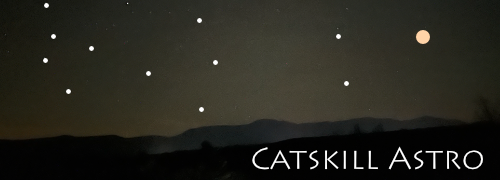Messier Objects
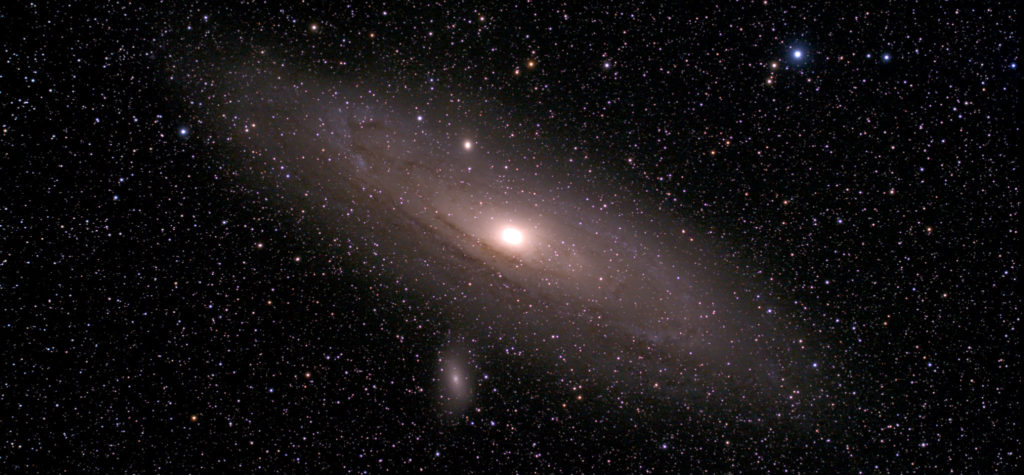
Page 7 of 11
Messier observations 61-70 of 110 total to date.
| Catalog # | Thumbnail | Title/link | Description |
|---|---|---|---|
| M61 | 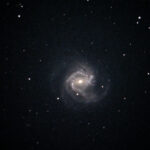 |
M61 / NGC 4303 | Barnabus Oriani is credited with the discovery of this nebula on May 5, 1779, 6 days before Charles Messier's independent discovery. Both were observing the comet of that year, and had mistaken the nebula for the comet on the same day, However, Messier mistook it for two nights more, failing to notice that did not move and did not record his observation until May 11, 1779. Oriani noticed his mistake immediately. Messier's catalog entry: "Nebula, very faint & difficult to perceive. M. Messier mistook this nebula for the Comet of 1779, on the 5th, 6th & 11th of May; on the 11th he recognized that this was not the Comet, but a nebula which was located on its path & in the same point [place] of the sky.". <--> This is a lovely Intermediate spiral galaxy... meaning intermediate between a classic spiral and barred. The spiral structure is prominent in the brighter, more central section of the galaxy. However the brightest part of the center is beginning to elongate into a bar, and the outer arms of the galaxy are taking on a classic reverse "S" shape characteristic of more mature, barred galaxies. |
| M62 |  |
M62 / NGC 6266 | Messier is credited with M62's discovery (#28) on June 4, 1779. He records: "Very beautiful nebula, discovered in Scorpio, it resembles a little Comet, the center is brilliant & surrounded by a faint glow.... M. Messier had already seen this nebula on June 7, 1771, without having determined the position where it is close to. Reviewed on on March 22, 1781.' <--> M62 is ranked 9th and 12th respectively for brightness and size. It's also considered one of the most irregular of the Messier GCs, originally reported by Herschel. Given the limited resolution of the Seestar image, it doesn't make sense to try to measure it here, but it's clearly elongated in my image along the 11 to 5 o'clock axis. This is another of my observations from the Ashokan Reservoir. At dec -30, M62 never really rises above my treeline (see M6) Altogether this is one of 6 Messier targets I managed from this site over the course of an hour and a half. |
| M63 |  |
M63 / Sunflower Galaxy / NGC 5055 | This is the first object in the catalog discovered by Méchain on June 14, 1779, still harvesting the fruits of observing the comet of 1779. Messier noted: "Nebula discovered by M. Méchain in Canes Venatici. M. Messier searched for it; it is faint, it has nearly the same light as the nebula reported under no. 59 [M59]: it contains no star, & the slightest illumination of the micrometer wires makes it disappear: it is close to a star of 8th magnitude.... M. Messier has reported its position on the Chart of the track of the Comet of 1779." <--> In my observation, M63 was in a prime observing location except for its proximity to the full moon, which upset the color balance. I opted to convert the image to monochrome and enhance it as such. The structure is much more evident. It's a fascinating, tight spiral, nearly circular. The sunflower moniker is apt, as it's bright enough to give us a good view of the disc's side... it appears to be floating, facing the sun. Lovely! |
| M64 | 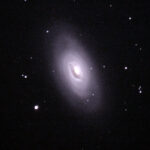 |
M64 / Evil Eye Galaxy / NGC 4826 | This is the second discovery by Pierre Méchain after a gap of 10 months on March 1, 1780. The catalog reads: "Nebula discovered in Coma Berenices, which is about half as apparent as that which is below the hair [M53]. M. Messier has reported its position on the Chart of the Comet of 1779." <--> This observation updates an earlier one dating from July 3, 2023 using the Askar V. My excuse for returning to M64 was the June 24 CN EAA challenge. You can see both in the gallery, though the featured images are the newer ones. I used Bin2 on the camera, which improves its light gathering speed, but doubles the size of the pixels. It provided a beautiful, nearly noise-free capture in only 30m of integration time. It's obviously a better capture than the Askar at 600m, and you don't actually lose visual resolution in Bin2 due to limitations in seeing anyway. |
| M65 | 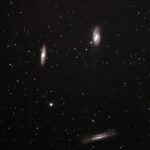 |
Arp 317 / M65 / Leo Triplet | Discovered by Messier (#29) on March 1, 1780 who recorded additional details in the entry for M66. Here he notes only: "Nebula discovered in Leo: It is very faint and contains no star." <--> This is one of my favorite targets, a stunningly beautiful group of three spiral galaxies. There are multiple observations here with different orientations. Tech details are for most recent triplet image, featured. M66 appears to be bent slightly by the attraction to M65. Arp seems to agree with me, as he remarks: "Both galaxies on east show signs of interaction." All three galaxies are quite bright, distinctly visible even after 60 seconds of integration. I have attached a "bonus" image which is a SeeStar 50 capture -- my first of the Triplet -- during a very dark and clear morning. This is the best galaxy capture I've achieved with this $500 automated telescope, and demonstrates what it can achieve when conditions are "perfect". I've also added to the gallery a capture from March of 2025, representing my first ever of M65 stand-alone, outside of the Triplet. Captured with my EdgeHD, 0.7x reducer, and Apollo M-Mini mono camera. |
| M66 | 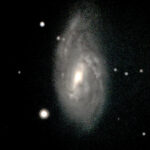 |
Arp 16 / M66 / NGC 3627 | Messier discovered M66 (#30) on the same day as M65, March 1, 1780. Some scholars credit Méchain, but I've relied on the catalog entry, where Méchain is normally credited. Here the catalog states: "Nebula discovered in Leo; its light is very faint & it is very close to the preceding [M65]: They both appear in the same field [of view] in the refractor. The comet of 1773 & 1774 has passed between these two nebulae on November 1 to 2, 1773. M. Messier didn't see them at that time, no doubt, because of the light of the comet." <--> This observation shows a lovely barred spiral galaxy on a Full Moon evening. Obviously, the broad outline of the target was instantly visible in SharpCap, but the surface brightness was lower than expected. Note that Arp lists the Triplet as Arp 317, and M66 separately as Arp 16. I presume Arp's "detached segments" refers to the upper arm being pulled away from the disk which gives M66 its distinctive, teardrop shape. I imagine that the arm was pulled away by an encounter with another galaxy at some point. Also indicating some sort of disturbance, the plane of the central bar is angled-in slightly towards the back of the disk compared to the plane of the disk and outer arms. |
| M67 | 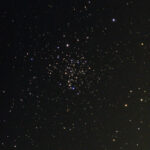 |
M67 / Golden Eye Cluster / NGC 2682 | Discovered by German astronomer Johann Gottfried Koehler before 1779, Messier's entry on April 6, 1780 is terse: "Cluster of small stars with nebulosity, below the southern claw of Cancer. The position determined from the star Alpha [Cancri]." <--> This open cluster is denser than most and ellipsoidal in outline, reminiscent of an eye, rotated slightly counter-clockwise. The illusion is enhanced because the majority of stars are found towards the center, golden yellow in color, representing the iris. |
| M68 | 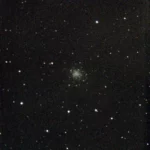 |
M68 / NGC 4590 | Messier is credited with discovery (#31) on April 9, 1780, noting: "Nebula without stars below Corvus & Hydra; it is very faint, very difficult to see with the refractors; near it is star of sixth magnitude." <--> M68 is ranked 23 and 21 respectively in terms of brightness and size among all Messier GCs, putting it pretty far down the pecking order. While it's challenging to say too much more given the limited resolution of my capture, M68's bright core appears to be wider than tall. This night was supposed to be cloudy but was briefly clear. This was an opportunistic observation, taking advantage of the quick setup time for the Seestar. You can see a thin layer of high clouds in the background but M68 is bright enough to show through... |
| M69 | 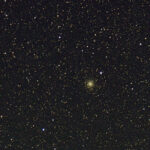 |
M69 / NGC 6637 | Discovery of M69 is attributed to Messier (#32) on August 31, 1780, despite the fact that he was attempting to confirm La Callie's observation. The consensus is he found something new: 1.2° away from La Caille's reported position. There is a grouping of three stars of mag 8.3, 7.8, 8.7 at La Caille's reported position, which might well have looked like a nebula in his modest, 0.5" aperture instrument. [messier.seds.org]. Messier observed with a 3" aperture telescope and his entry reads: "Nebula without star, in Sagittarius, below his left arm & near the arc; near it is a star of 9th magnitude; its light is very faint, one can only see it under good weather, & the least light employed to illuminate the micrometer wires makes it disappear.... this nebula has been observed by M. de La Caille, & reported in his Catalog; it resembles the nucleus of a small Comet. (diam 2')" <--> M69 ranks 20 and 25 respectively in terms of brightness and diameter among all Messier GCs. At Dec -32, it's one of the most southerly and impossible to view from my back yard.. This is another target I imaged from the Ashokan Reservoir, which delivers a very low southern horizon... Despite the limited reach of my Seestar, the core appears to be attractively symmetrical, nearly round. |
| M70 | 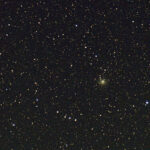 |
M70 / NGC 6681 | M70 is the near twin of M69, also at DEC -32 and discovered by Messier (#33) on the same date, August 31, 1780. As the catalog records: `Nebula without star, near the preceding [M69], & on the same parallel: near it is a star of the ninth magnitude & four small telescopic stars, almost on the same straight line, very close to one another, & [they] are situated above the nebula, as seen in a reversing telescope". <--> M70 is ranked 24 and 26 respectively for brightness and diameter among all Messier GC's. This is another object I captured from the Ashokan Reservoir, taking advantage of its flat southern horizon. You can see the four "telescopic" stars that Messier alludes to in my capture, etching a straight line vertically from the left side of the cluster. It resembles a quarter note in musical notation, flipped L to R. Unlike, M69, on close examination the core is distorted, with some bright stars extending the core towards 2 o'clock. |
